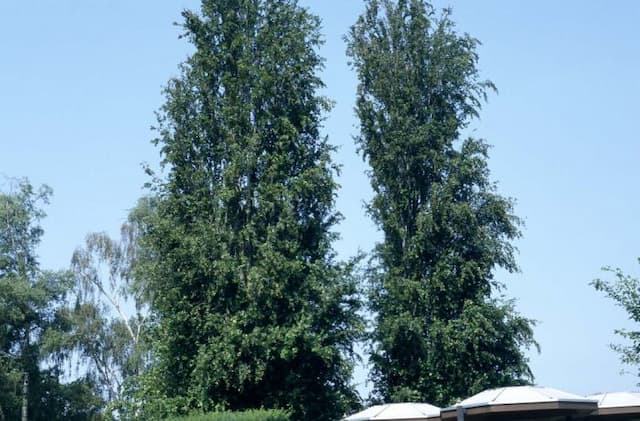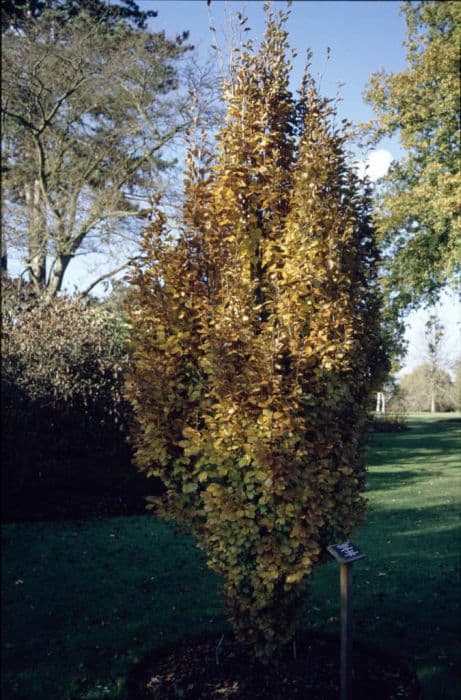Variegated Chestnut Castanea sativa 'Albomarginata' (v)

ABOUT
The Castanea sativa 'Albomarginata', commonly known as the variegated sweet chestnut, is particularly striking due to its distinctive leaves and ornamental qualities. This cultivar features leaves that are edged with a creamy-white to pale yellow margin, creating a sharp contrast with the darker green center. This variegation adds a light, dappled appearance to the foliage. The leaves themselves are typically oblong-lanceolate, with pointed tips and a serrated edge, which gives them a slightly ruffled look. In seasonal changes, the leaves may develop gold or bronze tinges, enriching the plant's color palette. The variegated sweet chestnut would typically produce flowers like the standard species, with long, catkin-like blooms that add to its decorative appeal. The bark of this cultivar retains the rugged, furrowed character common to sweet chestnuts, providing additional textural interest. As a member of the sweet chestnut family, it may also bear the characteristic spiny fruit husks that contain edible nuts, which are valued both for their taste and their ornamental qualities when they appear on the tree. Overall, the variegated sweet chestnut makes for an attractive plant with a mix of colors and textures that can enhance the visual interest of a garden or landscape setting.
About this plant
 Names
NamesFamily
Fagaceae
Synonyms
Variegated Sweet Chestnut, Variegated Spanish Chestnut
Common names
Castanea sativa 'Variegata'.
 Toxicity
ToxicityTo humans
The sweet chestnut is not considered toxic to humans. It is indeed cultivated for its edible nuts, which can be consumed safely when cooked. There are no known toxic consequences of ingesting any part of the sweet chestnut tree by humans, assuming the individual does not have specific allergies or health conditions that could be triggered by consuming chestnuts or other parts of the plant.
To pets
The sweet chestnut is generally not considered poisonous to pets either. The nuts can be a choking hazard for smaller pets and may cause digestive upset if consumed in large quantities. However, sweet chestnut is not typically associated with severe toxicity or poisoning in pets. As with any non-standard food, moderation is key to prevent gastrointestinal upset.
 Characteristics
CharacteristicsLife cycle
Perennials
Foliage type
Deciduous
Color of leaves
Variegated
Height
40 feet (12 meters)
Spread
30 feet (9 meters)
Plant type
Tree
Hardiness zones
5
Native area
Europe
Benefits
 General Benefits
General Benefits- Ornamental Value: Castanea sativa 'Albomarginata', commonly known as variegated chestnut, has distinctively variegated leaves that add visual interest to landscapes and gardens.
- Shade Provider: As a tree, it can grow to a significant size, providing shade and reducing heat in its immediate area.
- Attracts Wildlife: Its flowers can attract pollinators such as bees, while the nuts are a food source for various birds and mammals.
- Edible Nuts: The tree produces chestnuts that can be harvested and consumed by humans, adding a source of food from the garden.
- Seasonal Interest: Offers seasonal display from the spring blossoms to the autumn foliage and nuts.
- Carbon Sequestration: Like other trees, it absorbs carbon dioxide from the atmosphere, helping to mitigate climate change.
- Soil Improvement: Tree roots can help prevent soil erosion and improve soil structure over time.
 Medical Properties
Medical PropertiesThis plant is not used for medical purposes.
 Air-purifying Qualities
Air-purifying QualitiesThis plant is not specifically known for air purifying qualities.
 Other Uses
Other Uses- Variegated Sweet Chestnut wood can be used for furniture-making due to its durability and appealing grain pattern, providing an aesthetic option for woodworkers and carpenters.
- The bark of the Variegated Sweet Chestnut has been historically used for tanning leather, utilizing the tannins found within it to process hides.
- Leaves of the Variegated Sweet Chestnut can be used to enrich compost as they decompose to add nutrients back into the soil.
- The flowers of the Variegated Sweet Chestnut are a source of pollen for bees and other pollinating insects, supporting local biodiversity and honey production.
- The timber of the Variegated Sweet Chestnut can be used in traditional cooperage for making barrels and casks for aging wines and spirits.
- Variegated Sweet Chestnut is often used in landscape design for its decorative foliage, providing a striking contrast in gardens and parks.
- The leaves and twigs of the Variegated Sweet Chestnut can be used in floral arrangements, especially in autumn displays for their seasonal color and texture.
- Mature Variegated Sweet Chestnut trees can serve as excellent shade trees in large gardens or public spaces, offering a cool resting spot during warm months.
- Small branches and twigs from the Variegated Sweet Chestnut can be used in craft projects or as kindling for fires, due to their ease of ignition.
- The dense canopy formed by a mature Variegated Sweet Chestnut can act as a sound barrier, reducing noise levels in urban environments.
Interesting Facts
 Feng Shui
Feng ShuiThe Sweet Chestnut is not used in Feng Shui practice.
 Zodiac Sign Compitability
Zodiac Sign CompitabilityThe Sweet Chestnut is not used in astrology practice.
 Plant Symbolism
Plant Symbolism- Longevity and Perseverance: As a variety of Castanea sativa, commonly known as the Sweet Chestnut, this plant is renowned for its ability to live for many years. The Sweet Chestnut can endure for centuries, symbolizing the ability to withstand the test of time and to overcome challenges.
- Provision and Abundance: The Sweet Chestnut is a prolific producer of nuts that have historically been a significant food source. This abundance symbolizes generosity and providing for others, signifying plentifulness and nourishment.
- Strength and Resilience: The wood of the Sweet Chestnut is strong and durable, which has made it valuable for building and carpentry. This characteristic represents strength and the capacity to hold firm in the face of adversity.
- Healing and Restoration: Historically, the Sweet Chestnut has been used for medicinal purposes, with parts of the plant being used to treat various ailments. This aspect of the Sweet Chestnut symbolizes healing and the power to restore health.
 Water
WaterThe Sweet Chestnut 'Albomarginata' variety requires consistent moisture, especially during its growing season. Water the plant deeply once a week, providing approximately 1 to 1.5 gallons of water each time, to ensure that the root zone is thoroughly moistened. During hot dry spells, you might need to water twice a week to prevent the soil from drying out completely. In the dormant season, reduce watering frequency to every two weeks, unless there is sufficient rainfall. Always check the soil moisture before watering; it should be moist but not waterlogged.
 Light
LightThe Sweet Chestnut 'Albomarginata' thrives in full sunlight to partial shade. It prefers a location where it can receive at least four to six hours of direct sunlight daily. Although this plant can tolerate some light shade, the best growth and foliage quality are achieved in a spot with ample sunlight. Avoid planting in deep shade as this can lead to sparse foliage and poor health.
 Temperature
TemperatureSweet Chestnut 'Albomarginata' is hardy and can withstand a range of temperatures. This plant can survive in temperatures as low as 20 to 25 degrees Fahrenheit, while the upper limit is around 100 degrees Fahrenheit. The ideal temperature range for this chestnut variety is between 50 and 75 degrees Fahrenheit, where it can grow and develop optimally. Make sure to protect the plant from extreme cold by providing mulch or shelter if necessary.
 Pruning
PruningPruning the Sweet Chestnut 'Albomarginata' is primarily done to shape the tree and remove any dead or diseased wood. It is best to prune during the dormant period, typically in late winter before new growth begins. This timing helps prevent disease and allows the tree to heal properly. Only prune as necessary to maintain the desired structure and health of the tree, avoiding excessive cutting which can stress the plant.
 Cleaning
CleaningAs needed
 Soil
SoilThe Variegated Sweet Chestnut prefers well-draining, deep, fertile soil with a pH of 4.5 to 7.5. A mix of loam, peat, and well-rotted compost is ideal, providing nutrients and adequate moisture retention.
 Repotting
RepottingVariegated Sweet Chestnut trees are typically not repotted as they are large and grow outdoors; however, young trees should be planted in progressively larger pots until they're ready for a permanent outdoor location.
 Humidity & Misting
Humidity & MistingVariegated Sweet Chestnut thrives in moderate to high humidity levels; ensure consistent environmental moisture without making the air too damp.
 Suitable locations
Suitable locationsIndoor
Not suitable for indoor growth; requires outdoor space.
Outdoor
Plant in a sunny spot, shelter from strong winds, well-draining soil.
Hardiness zone
5-7 USDA
 Life cycle
Life cycleCastanea sativa 'Albomarginata', commonly known as the variegated sweet chestnut, begins its life cycle as a seed, which germinates in favorable conditions of moisture and warmth, usually in the spring. The seedling emerges and develops into a juvenile tree, establishing a root system and a stem, with leaves featuring distinct white margins. As it matures, the tree enters a vegetative state, where it experiences significant growth in height and girth, producing a robust canopy. Once reaching reproductive maturity after several years, it begins to flower annually, predominantly in the summer, with male flowers in long catkins and female flowers in smaller, less conspicuous clusters. Following pollination, typically by insects or wind, the flowers develop into spiny cupules containing edible seeds, known as chestnuts, which mature by autumn and are then dispersed by gravity or animal vectors, completing the reproductive cycle. With the proper conditions and care, the variegated sweet chestnut can live for many years, potentially centuries, before it eventually senesces and dies.
 Propogation
PropogationPropogation time
Spring to Summer
Propogation: The European chestnut 'Albomarginata', a variegated cultivar of Castanea sativa, is typically propagated by grafting, which is the most common and popular method used for this particular cultivar due to its ability to reliably produce plants that are true to the parent's characteristics. Grafting is performed during the dormant season, usually in late winter or early spring. A scion, which is a piece of the 'Albomarginata' with at least one bud, is carefully joined to a rootstock of a seedling chestnut tree. The graft site is then sealed with grafting wax or tape to hold the pieces together and prevent drying out. Over the following season, the scion and rootstock grow together, forming a new tree that combines the root vigor of the stock with the desirable traits of the 'Albomarginata' scion.









